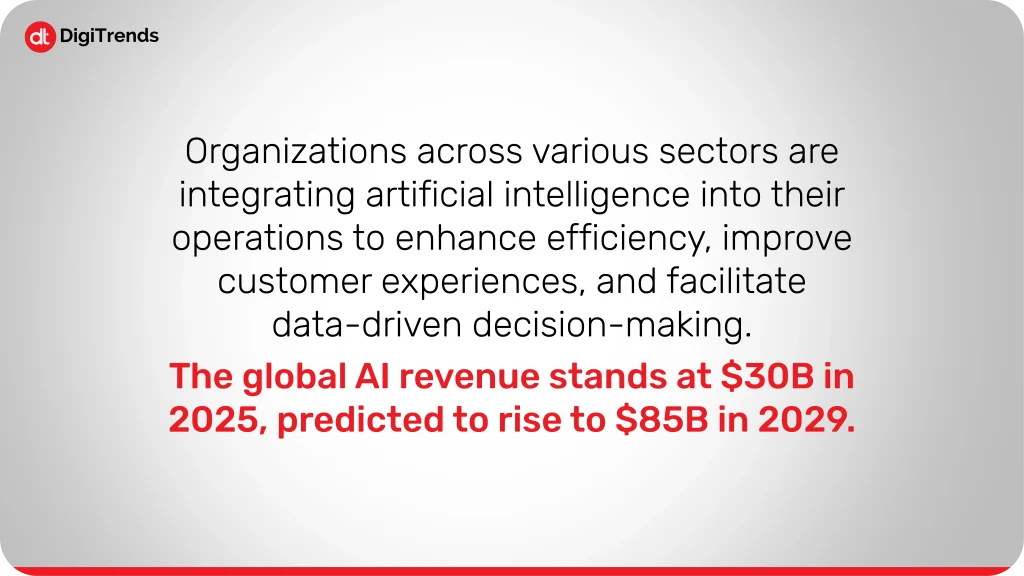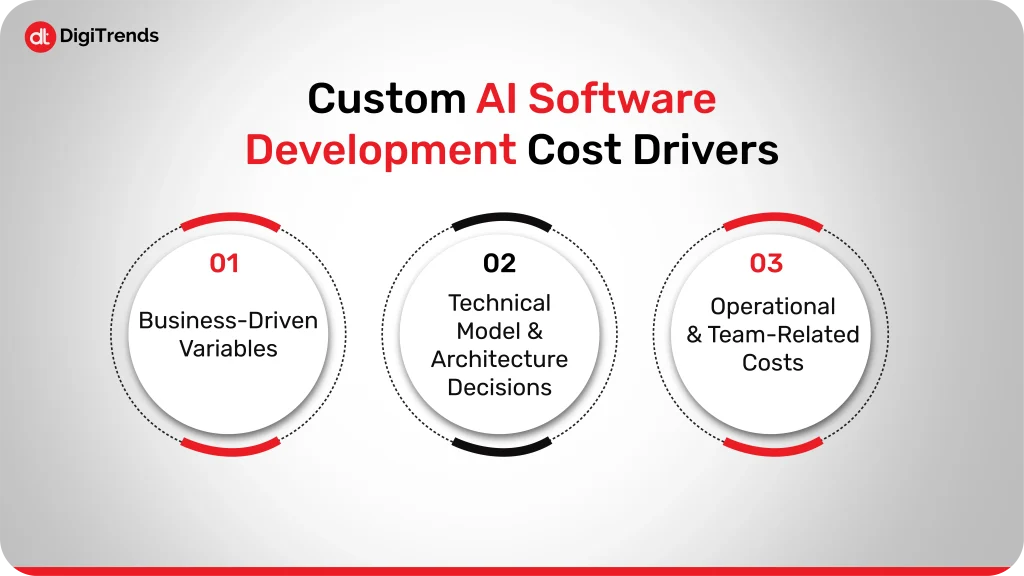Table Of content

We are all aware of the fact that the demand for AI solutions is rising very fast, and this demand is driven by advancements in machine learning, natural language processing, computer vision, and automation technologies. According to S&P Global, the Global AI revenue stands at approximately $30B in 2025, predicted to rise to $85B in 2029. No matter which industry, organizations of various sectors are planning to or have already integrated artificial intelligence into their operations because AI helps enhance efficiency, customer experiences, and also helps with efficient decision making.
Now, the main question for businesses that are looking to integrate AI in their operations is exactly how much AI software development costs, because as AI systems have now become more complex and specialized, the cost of development has become a critical consideration for businesses and startups. There are so many factors, like project scope, algorithm complexity, data processing needs, infrastructure, and the level of customization, that influence the AI software development cost.
If you are also looking to build AI solutions for your company or startup, but are not sure of the budget and pricing, don’t worry, we’ve got you covered.
This blog will provide an in-depth analysis of the current AI development landscape and outline everything that can influence or determine the AI software development cost.

AI Software Development Cost Breakdown
If you are looking to build an AI software, there are various variables that you’ll have to keep in mind while budgeting for AI development costs in 2025. The variables that you have to consider include the type of AI product being built and the various phases involved in the development process. These factors are important to consider for budgeting because every AI project has its levels of complexities, timelines, and resource requirements, all of which directly impact the final cost.
Let’s have a look at a structured overview of typical pricing ranges for AI software development:
Custom AI Software Development Cost by Product Type:
| Product Type | Estimated Cost (USD) |
| Chatbot / Virtual Assistant | $20,000 – $50,000 |
| Predictive Analytics Platform | $40,000 – $100,000 |
| AI-Powered Mobile App | $35,000 – $90,000 |
| Computer Vision System | $50,000 – $120,000 |
| Natural Language Processing Tool | $60,000 – $150,000 |
| Recommendation Engine | $30,000 – $80,000 |
| Custom AI Enterprise Solution | $100,000 – $300,000+ |
This table shows that the custom AI software development cost largely depends on the nature of the AI model, the amount of training data required, real-time capabilities, and integration needs with existing systems. For example, if you build a simple AI chatbot, the cost to build it will comparatively be more affordable, whereas for developing an enterprise-grade AI software, you will need more budget.
Cost Breakdown by Development Phase:
| Development Phase | Estimated Cost (USD) | Typical Cost Share% |
| Business Analysis & Planning | $5,000 – $30,000 | 5% – 10% |
| Data Collection & Preparation | $15,000 – $75,000 | 15% – 25% |
| Model Development & Training | $25,000 – $105,000 | 25% – 35% |
| Backend & Frontend Development | $15,000 – $75,000 | 15% – 25% |
| Testing & QA | $10,000 – $45,000 | 10% – 15% |
| Deployment & Maintenance | $10,000 – $60,000 | 10% – 20% |
Build Intelligent AI Software Solutions
Contact us to design and develop cutting-edge AI-powered applications that enhance user experiences, streamline operations, and drive innovation.
Get StartedDifferent steps in AI software development require different budgets; the table above shows the costs needed for every step, from planning to deployment. The phase that needs the most resources is model training and data preparation, as these phases require interactive testing and a highly skilled team. Meanwhile, deployment and post-launch maintenance ensure long-term performance, adaptability, and scalability.
Looking at the tables above, you will get a clear cost breakdown by product type and development phase. This breakdown will help you prioritize your investments and set expectations for your budget that are realistic. It will also help you in planning your project effectively and finding ways for cost-effective AI development.

Custom AI Software Development Cost Drivers
No matter what type of software development you are planning for, whether it is healthcare software, educational software, or AI software, it is dependent on various factors. In the case of AI software development, there are also variables that are related to business, technology, and operational factors that will help in determining the costs.
These cost drivers are important to keep in mind because they will determine how much time, talent, and what type of design will be required to build an AI solution that is good in functionality and also scalable. If you have a clear understanding of these elements, you will be able to manage risks, make better budgets, and plan a good strategy for AI software development.
Let’s have a look at the custom AI software development cost drivers:
1. Business-Driven Variables
Monetization Strategy:
When you build software, you will also need to monetize it, and that will include subscriptions, advertisements, data licensing, or pay-as-you-go. These strategies for monetization determine the structure and complexity of the software you are looking to build. To take another illustration, a pay-per-use system might need dynamic data processing and usage tracking, and this will come with added costs for both building the infrastructure and the engineering.
Compliance, Licensing & Legal Costs:
Often underestimated, these hidden costs can significantly impact overall budgets. Projects dealing with sensitive data or operating in regulated industries must factor in legal advisory fees, licensing restrictions, and compliance audits. These expenses can account for more than 20% of the total development cost in some cases.
2. Technical Model & Architecture Decisions
Type of AI Technology
The choice between traditional machine learning, deep learning, or large language model (LLM) based generative AI has a major effect on costs. Deep learning and LLMs typically require more data, higher computational power, and longer training times, resulting in greater complexity and investment.
Model Training & Optimization
Custom-trained models developed using proprietary datasets offer higher accuracy and business alignment, but they also raise costs significantly. Compared to pre-trained or rule-based systems, tailored models require extensive experimentation, tuning, and validation, especially when applied at scale.
3. Operational & Team-Related Costs
Team Structure & Resourcing
The structure of the development team has a direct influence on cost. In-house teams offer greater control but come with higher overhead, while outsourced or hybrid models may be more cost-effective yet require strong project management. Roles such as data scientists, ML engineers, DevOps specialists, and UX designers all contribute to the cost structure.
Technology Stack & Integrations
The selected tech stack, including cloud platforms, machine learning frameworks, data pipelines, and third-party APIs, plays a pivotal role in determining both upfront and recurring costs. Integration with legacy systems or third-party services often introduces additional engineering and maintenance requirements.
Together, these cost drivers form the foundation of any AI development budget. Strategic choices in architecture, execution, and business alignment can dramatically shift the cost curve. For organizations investing in AI in 2025, success depends not just on building advanced solutions but on managing the hidden variables that define the real price of innovation.
Importance of the Cost Drivers
Understanding cost drivers is essential not only for accurate budgeting but also for setting realistic project expectations and maximizing return on investment. Each cost driver directly influences how efficiently an AI solution is developed, deployed, and scaled over time.
Failing to account for these variables can lead to underestimated budgets, delayed timelines, and performance gaps. For example, overlooking data preparation or compliance requirements can result in costly mid-project revisions. Similarly, investing in advanced AI models without aligning them with actual business needs may inflate costs without delivering proportional value.
By identifying and managing these drivers early in the development process, organizations can:
- Allocate resources more effectively
- Choose the right level of technical sophistication
- Avoid costly rework and delays
- Optimize operational planning
- Ensure long-term scalability and maintainability
In the evolving AI landscape, cost-efficiency is not about cutting corners; it’s about making informed, strategic decisions at every stage of the development cycle.
Factors Affecting AI Software Development Cost
While every AI project is unique, several foundational elements universally impact the total development cost. Understanding these variables is essential for building a realistic financial and technical roadmap. These factors often interact with each other, amplifying or reducing costs depending on their scale, depth, and execution.
Let’s have a look at the factors affecting AI software development cost:
1. Project Complexity
The more complex the functionality of an AI solution, the higher the cost. Simple automation tools or rule-based systems are typically less expensive compared to advanced systems like generative AI platforms, autonomous agents, or multi-modal models. Complexity affects algorithm choice, model architecture, data requirements, testing cycles, and more.
- Example: A sentiment analysis tool is simpler and cheaper to develop than an AI agent capable of real-time multilingual conversation.
2. Data Volume & Quality
Data is the lifeblood of any AI system. Costs rise significantly when a project requires large-scale data gathering, cleaning, annotation, or real-time streaming. Additionally, poor data quality may necessitate additional processing cycles or human validation, increasing both time and budget requirements.
- Tip: Using synthetic or pre-labeled datasets can sometimes reduce time-to-market but may compromise precision in niche domains.
3. Scalability Requirements
If your AI product needs to serve thousands or millions of users, or operate across global infrastructures, expect higher engineering, hosting, and maintenance costs. Building for scale requires robust backend architecture, auto-scaling cloud environments, and constant performance monitoring.
- Scalable AI must be optimized for high throughput, failover handling, and low-latency performance; each layer adds to the cost.
4. Level of Personalization
Custom AI models built for specific industries, users, or business processes demand more effort in terms of data alignment, training, and feature engineering. Off-the-shelf models are quicker and cheaper to implement, but often don’t meet enterprise-level accuracy or compliance requirements.
- Highly tailored models improve value delivery but raise cost due to intensive R&D, training iterations, and post-deployment fine-tuning.
5. Real-Time Capabilities
Adding real-time processing, such as AI for fraud detection, recommendation systems, or predictive maintenance, requires higher compute power, low-latency APIs, and fast data pipelines. This results in increased infrastructure costs and performance testing.
- Latency-sensitive AI systems often involve edge computing or advanced cloud configurations, both of which raise budget needs.
6. User Experience (UX) & Interface Design
AI models are only as good as their usability. Developing intuitive dashboards, interactive AI assistants, or data visualizations often involves design experts and front-end engineers, which contributes to the overall development cost.
- AI product success depends on both model performance and user adoption. Investing in UX ensures the solution is practical and accessible.
7. Security & Compliance Requirements
Security protocols like encryption, access control, and audit trails, along with compliance frameworks (GDPR, HIPAA, etc.), introduce legal and technical obligations that inflate cost. This is especially true for AI in finance, healthcare, or government sectors.
- Neglecting compliance early can lead to hefty fines, rework, or regulatory pushback.
Why These Factors Matter
These cost-affecting factors are more than just technical checkboxes; they define the viability, scalability, and long-term success of your AI project. By carefully evaluating each one, organizations can build development roadmaps that reflect not only the technical ambition but also the commercial realities of deploying AI in 2025 and beyond.
AI Software Features That Significantly Impact Custom Development Cost
When it comes to building custom AI solutions, the features you choose to include can dramatically influence your overall development cost. Some functionalities require more engineering effort, data complexity, and processing power than others. Understanding which features drive up cost, and why, can help you prioritize wisely, especially during early planning or MVP development.
Let’s have a look at the strategic breakdown of the features that decide the AI development cost in 2025:
1. Natural Language Understanding (NLU) & Conversational AI
Enabling machines to interpret and generate human language isn’t just about integrating a chatbot; it involves intent recognition, entity extraction, multilingual support, and real-time responses. Advanced conversational agents require deep learning models, context retention, and sometimes emotional analysis.
2. Real-Time Processing & Decision-Making
AI systems that need to operate in real-time (like fraud detection, recommendation engines, or autonomous systems) must be optimized for low-latency performance. This often requires specialized infrastructure, edge computing setups, and fast model inference layers.
3. Computer Vision Capabilities
AI features involving image or video recognition (e.g., facial detection, object tracking, anomaly detection in visual data) require large labeled datasets, computationally heavy models, and continuous model updates to maintain accuracy in diverse environments.
4. Recommendation Engines
Personalized recommendation engines analyze user behavior, preferences, and interaction history in real time. Implementing these systems involves user profiling, collaborative filtering, ranking algorithms, and A/B testing loops to improve results.
5. Predictive Analytics & Forecasting
While predictive analytics can be relatively straightforward using basic models, industry-specific or multi-variable forecasting (e.g., in healthcare, finance, or logistics) often requires custom data engineering, validation routines, and continuous retraining.
6. User Behavior Modeling & Personalization
Capturing, processing, and adapting to individual user behavior in real time adds layers of complexity, such as building user profiles, integrating behavioral analytics, and dynamically adjusting experiences.
7. Autonomous Decision-Making / Agents
Autonomous agents or decision-making systems operate with limited or no human input. These can include AI in robotics, logistics routing, smart assistants, or operational automation. They demand high-level reasoning, real-world adaptability, and safe failover mechanisms.

AI Software Development Costs Across Key Industries
AI technology is rapidly transforming industries by automating tasks, enabling real-time insights, and improving user experiences. However, the cost of AI software development can vary significantly depending on the industry, driven by factors such as regulatory requirements, data complexity, performance expectations, and the level of customization needed.
Let’s have a look at the breakdown of common industries investing in AI and what typically drives their development costs:
1. Healthcare & Life Sciences
AI in healthcare is used for diagnostics, predictive analytics, patient monitoring, medical imaging, and drug discovery. These applications require high precision, compliance with HIPAA and other data privacy laws, and integration with electronic health records (EHRs).
Typical Cost Range: $80,000 – $300,000+
Why Cost is High: Data sensitivity, regulatory compliance, and the need for explainable AI models that support clinical decisions
2. Finance & Banking
Financial institutions deploy AI for fraud detection, algorithmic trading, credit scoring, and customer service chatbots. These systems must be highly accurate, auditable, and secure.
Typical Cost Range: $100,000 – $250,000+
Why Cost is High: Real-time processing, complex rule engines, and strong emphasis on cybersecurity and compliance.
3. Retail & eCommerce
AI powers recommendation systems, inventory forecasting, personalized marketing, and customer service bots. These solutions often rely on vast user behavior data and require seamless integration across web, mobile, and CRM platforms.
Typical Cost Range: $40,000 – $150,000
Why Cost is Moderate to High: Real-time personalization, cross-platform data pipelines, and large-scale customer interaction models
4. Transportation & Logistics
AI optimizes routing, demand forecasting, fleet management, and autonomous vehicle systems. These solutions typically require complex real-time data processing and integration with GPS, IoT sensors, and traffic systems.
Typical Cost Range: $70,000 – $250,000
Why Cost is High: High-performance computing for route optimization and the challenge of managing and reacting to real-time sensor data
5. Manufacturing & Industrial Automation
AI applications in this sector include predictive maintenance, quality control via computer vision, robotics, and supply chain optimization. The environment often involves edge computing and hardware-software integrations.
Typical Cost Range: $60,000 – $200,000
Why Cost is High: Physical system integration, real-time analytics, and data from machinery that needs constant monitoring and interpretation
6. Education & EdTech
AI is used to deliver adaptive learning platforms, student performance prediction, and content personalization. These solutions vary greatly depending on scale (K-12 vs higher ed) and interactivity.
Typical Cost Range: $30,000 – $120,000
Why Cost is Lower to Moderate: Less regulatory complexity, but still requires user personalization, content tagging, and scalable cloud deployment
7. Media, Marketing & Entertainment
AI is transforming content generation, campaign targeting, trend analysis, and audience engagement through automation. This industry often requires multi-modal AI (text, image, audio).
Typical Cost Range: $50,000 – $140,000
Why Cost Varies: Depends on media type, real-time generation capabilities, and the scale of analytics or content distribution.
AI adoption is not one-size-fits-all, and neither is the cost. Different industries require different levels of precision, integration, and compliance, all of which influence the budget required to develop effective AI solutions. By understanding the domain-specific needs and challenges, businesses can plan their AI investments more strategically and avoid unexpected cost escalations down the road.
Careful alignment between business goals and AI capabilities is key to ensuring that the investment leads to measurable value, no matter the industry.
Monetization Strategies for AI Software
Developing a powerful AI solution is only part of the equation; ensuring it generates sustainable revenue is equally critical. As AI products continue to expand across industries, businesses are adopting diverse monetization strategies to match user behavior, data value, and product functionality.
Whether you’re offering AI as a standalone platform or embedding it into a broader service, the right revenue model can dramatically impact profitability, scalability, and customer retention.
Let’s have a look at the most effective AI monetization strategies being used in 2025:
1. Subscription-Based Model
A widely adopted model where users pay a recurring fee, monthly or annually, for access to the AI software. It’s often offered in tiers based on usage limits or feature sets and works well for tools that provide continuous value over time.
2. Pay-Per-Use / Consumption-Based Pricing
This model charges users based on how much they use the AI system, such as the number of API calls, processed items, or compute time. It offers flexibility, especially for businesses with fluctuating or unpredictable usage.
3. Freemium Model
Users can access basic AI features for free, with the option to unlock advanced tools or higher limits through paid upgrades. This strategy helps build a user base quickly while creating opportunities for conversion and upselling.
4. Data Licensing
Some AI solutions collect valuable data that can be anonymized, aggregated, and licensed to third parties. This strategy is common in industries like healthcare, retail, or finance, where data insights have high commercial value.
5. Advertising-Supported Model
For AI tools with a large user base or public-facing interface, such as virtual assistants, chatbots, or content recommenders, revenue can come from displaying targeted ads or sponsored results within the platform.
6. Outcome-Based Pricing
In this performance-driven model, pricing is tied to the results the AI helps achieve, such as increased revenue, reduced costs, or improved efficiency. It’s most effective when the ROI is measurable and attributable to the software.
The monetization model can help you directly impact product adoption, customer retention, and overall profitability. In many cases, hybrid approaches, like combining freemium with usage-based pricing or licensing with outcome-driven agreements, offer the flexibility needed to meet different market needs.
The key is to match the pricing structure with the value your AI solution delivers, ensuring it’s both accessible to users and sustainable for your business in the long run.
Cost Optimization Strategies for AI Projects
Building AI software can be a transformative investment, but also an expensive one if not managed strategically. Fortunately, there are several ways to optimize development costs without sacrificing quality, performance, or innovation.
Whether you’re a startup working with limited capital or an enterprise scaling an existing solution, smart planning and resource allocation can help you stay within budget while delivering meaningful results. The key lies in balancing ambition with efficiency, and leveraging tools, processes, and partnerships that reduce both technical and operational overhead.
Let’s have a look at some proven strategies to reduce AI development costs without cutting corners:
1. Start with an MVP
Instead of building a fully-featured AI system from day one, develop a lean MVP focused on solving one high-impact use case. This approach shortens time-to-market, minimizes initial costs, and provides valuable user feedback before scaling.
2. Use Pre-Trained or Open-Source Models
Pre-trained models (e.g., GPT, BERT, YOLO, ResNet) offer robust performance for many applications and significantly reduce the time and cost of development. Combined with open-source frameworks like TensorFlow, PyTorch, or Hugging Face, these resources eliminate the need to build everything from scratch.
3. Automate Data Labeling & Augmentation
Data preparation is often the most time-consuming and costly phase. Tools for automated labeling, synthetic data generation, and data augmentation can drastically reduce manual effort and improve dataset quality.
4. Prioritize Cloud & Infrastructure Efficiency
Choose cloud platforms with AI-specific services (like AWS SageMaker, Azure ML, or Google Vertex AI) that offer pay-as-you-go pricing. Auto-scaling, serverless deployments, and GPU scheduling help optimize compute usage and reduce idle costs.
5. Outsource Non-Core Components
Outsourcing the development of non-strategic modules, such as UI/UX, API integrations, or testing, can lower costs while keeping your internal team focused on the AI core. Be sure to maintain quality oversight and clear documentation to avoid future rework.
6. Reuse & Modularize Code
Adopting a modular architecture allows you to reuse components across multiple projects or iterations. This accelerates development cycles and avoids repetitive coding tasks.
7. Implement CI/CD & Automated Testing for AI
Setting up continuous integration and automated testing pipelines may require an upfront investment, but it saves significant time and cost over the long term. Automated tests catch issues early, reduce debugging effort, and ensure more stable deployments.
8. Plan for Post-Launch Efficiency
Maintenance and scaling are often underestimated cost centers. Set up performance monitoring, automate retraining pipelines, and maintain clear version control of models and data to avoid costly bottlenecks later.
AI development in 2025 is as much about strategic resource allocation as it is about cutting-edge innovation. The most successful organizations are those that build intelligently, not just ambitiously, by using the right tools, frameworks, and development models to keep costs under control without compromising performance.
At every stage of the journey, from initial planning to long-term scalability, teams that prioritize efficiency are better positioned to deliver lasting value. Forward-thinking digital solution companies like DigiTrends are increasingly helping businesses strike this balance by combining technical expertise with a deep understanding of cost-conscious development in real-world scenarios.
Because in today’s AI landscape, the goal isn’t just to build powerful systems, it’s to build them wisely.
Conclusion
As AI continues to reshape industries in 2025, understanding the true cost of development is essential, not just for budgeting but for building solutions that deliver lasting value. From product type and development phases to pricing models, industry demands, and strategic feature choices, every decision has a direct impact on cost, scalability, and ROI.
Organizations that approach AI development with clarity, flexibility, and a focus on outcomes are far better positioned to succeed. This means not only anticipating expenses but also choosing the right team, the right monetization model, and the right pricing structure to fit their goals.
Ultimately, investing in AI is not just a technological choice; it’s a strategic one. And with the right planning, it can become one of the most powerful drivers of innovation and competitive advantage in the years to come.








